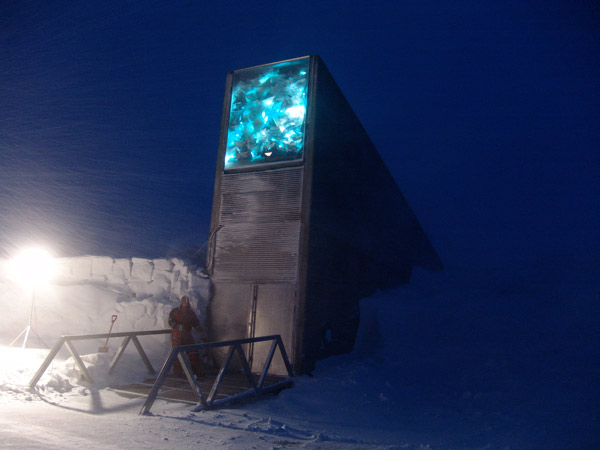Red Hot Chili Peppers Stored in Cool Arctic Doomsday Vault

Seeds from some of North America's hottest chili peppers were recently delivered to the cool Arctic and stored in the Svalbard Global Seed Vault, where they'll be safe for centuries in case some terrestrial catastrophe renders them otherwise extinct.
The so-called "doomsday seed vault" now contains seeds of more than 525,000 crop varieties from around the world, making it the most diverse assemblage of crops anywhere. The seed vault was constructed deep in a mountain on a remote Norwegian archipelago near the North Pole as a fail-safe back-up to existing crop collections around the world.
The new hot stash includes Wenk's Yellow Hots, a pepper that starts out yellow and hot and cools somewhat to red and medium-hot; Pico de Gallo or "Rooster's beak," a medium-hot salsa staple; and the unpredictable San Juan "Tsile," a New Mexico chili still grown by elder farmers in a Native American pueblo that can be anything from mild to medium to hot. [Related: Why Do Chili Peppers Taste Hot?]
"The world is interdependent when it comes to crop diversity, the essential raw material needed for a healthy and robust food supply," said Senator Benjamin L. Cardin (D-MD), who led a delegation that delivered the seeds. "As we manage the impact of climate change around the world, the seed vault in Svalbard will be the safety deposit box that ensures we can keep that food supply intact."
"The journey of the chili pepper from the indigenous cultures of the Americas to its current status as an essential ingredient in many Indian and Asian cuisines is a marvelous example of the global disbursement of agricultural diversity," said Senator Tom Udall (D-NM). "I'm very pleased that we are saving one of New Mexico's most famous and most delicious crops in the Svalbard Global Seed Vault."
The USDA's Agricultural Research Service (ARS) has sent tens of thousands of seeds from its National Plant Germplasm System to the Svalbard Global Seed Vault since January 2008.
"Our goal, over the next 10 to 15 years, is to have the majority of the system's 511,000 collections represented in the Svalbard vault," said Edward B. Knipling, ARS administrator.
Get the world’s most fascinating discoveries delivered straight to your inbox.
"While we've sent samples from some very familiar crop species, such as maize, soybeans, and peanuts, we're also sending more exotic germplasm, such as seeds of the wild strawberry Fragaria iturupensis, collected from the island of Iturup on the lower flank of the Atsunupuri Volcano in far eastern Russia," Knipling said. "ARS has a strong commitment to sharing its crop diversity to ensure that Svalbard is well positioned to help protect the world's genetic diversity."
Another important crop seeds put in the vault recently: sorghum.
Sorghum is a crop that is grown around the world and is a dietary staple for 500 million people in over 30 countries. It is getting renewed attention as a "climate change ready" crop due to its ability to withstand hot and dry conditions.
"Sorghum is an amazingly versatile crop — it's used for flour, bread, animal feed, beer and, increasingly, biofuels — and it's likely to become ever more important to global food security given its drought tolerance," said Cary Fowler, Executive Director of the Global Crop Diversity Trust, the institution that funds the operation and management of the Svalbard Global Seed Vault, as well as the transport of unique seeds from collections around the world.
"But production in many areas is threatened by insect pest and plant disease," Fowler said. "This intensifies the need to conserve sorghum diversity so that plant breeders can find the genetic traits they need to equip this important crop for these challenges.
- Radical Science Aims to Solve Food Crisis
- Americans Toss Out 40 Percent of All Food
- Doomsday News & Information



